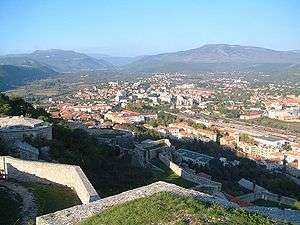Knin
| Knin | ||
|---|---|---|
| City | ||
|
View over Knin | ||
| ||
 Knin Location of Knin within Croatia | ||
| Coordinates: 44°02′N 16°11′E / 44.033°N 16.183°ECoordinates: 44°02′N 16°11′E / 44.033°N 16.183°E | ||
| Country |
| |
| County |
| |
| Government | ||
| • Mayor | Nikola Blažević (HDZ) | |
| Area | ||
| • Total | 355 km2 (137 sq mi) | |
| Elevation | 214 m (702 ft) | |
| Population (2011)[1] | ||
| • Total | 10,633 | |
| • Administrative area | 15,407 | |
| Time zone | CET (UTC+1) | |
| • Summer (DST) | CEST (UTC+2) | |
| Postal code | 22300 | |
| Area code(s) | 022 | |
| Climate | Cfa | |
| Website |
www | |
Knin (pronounced [knîːn]) is a city in the Šibenik-Knin County of Croatia, located in the Dalmatian hinterland near the source of the river Krka, an important traffic junction on the rail and road routes between Zagreb and Split. Knin rose to prominence twice in history, as the capital of both the medieval Kingdom of Croatia and, briefly, of the self-proclaimed Republic of Serbian Krajina at the end of the 20th century.
Etymology
The name is likely derived from the Illyrian Ninia.[2] The medieval names of Knin include Hungarian: Tinin; Italian: Tenin); Latin: Tinum. The Latin name is still used as a titular episcopal see, the Diocese of Tinum.
History

Ancient
The area consisting of today's Knin, or more specifically, the Spas hill, was inhabited since the stone age. In the vicinity of today's Knin was once a town called Burnum, which served as a Roman military camp in the 1st century BC.
Middle ages
Knin is first mentioned in the 10th-century work De Administrando Imperio as the centre of a županija (parish), and as one of the towns in Croatia. A royal monastery of Saint Bartholomew was founded on the location later known as Kapitul (bishopric of Knin), in the near vicinity of the Knin castle, by a certain Duke of Croatia, during the reign of king Stephen Držislav of Croatia in the 10th century.[3] Around 1040, at the behest of the Croatian kings, it became the seat of the royal bishop, whose see was placed in the church of Saint Mary in the field close to the Knin Fortress. The first bishop of Knin (also called "episcopus Chroatensis" - bishop of Croatia) is named Marko Giudice, and he and his successors were attached to the royal court as preachers and king's "special bishops" until 1102.[4][5]
Knin was first recorded as a more permanent royal residence of king Demetrius Zvonimir around 1080. Because of this, it has led to Knin being known as the "City of Croatian Kings" or "Zvonimir's City" (Zvonimirov grad) in recent times.[6] In the following decade, during the succession crisis, the city was the permanent residence of a local lord Petar Svačić, who contested the crown of Croatia until his defeat by king Coloman of Hungary in 1096. At that point, it came into possession of the Hungarian Arpad dynasty, and since then, it ceased to be a permanent royal residence but remained as a political and administrative center of the kingdom.
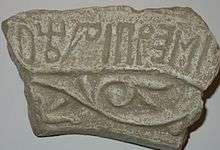
In 1178, it is for the first time mentioned as "civitates" (city) in a contemporary source, and during the 12th century it is less frequently mentioned than before and after.[7]
There is neither written mention, nor archaeological evidence of how Knin coped during the Mongol invasions of Europe, as Mongols passed through the area while reaching Klis in pursuit of Bela IV of Hungary. The city was visited by Queen Maria Laskarina, the daughter of the Byzantine Emperor and wife of king Bela IV, together with her retinue of nobles and a great number of soldiers in 1261. She convened an assembly in Knin to introduce her son to the Croatian nobility and to negotiate their oath in recognizing him as the designated duke (herceg). The queen subsequently left and imprisoned five high ranking individuals among the citizens of Split, after hearing they harassed and killed members of her retinue, and had them transferred to the Knin dungeons afterwards.[8] In 1264, the first case of judicial function in the city was mentioned involving the Croatian ban and the nobility of the kingdom in a dispute between a citizen of Zadar and another individual. During this time, Knin was the seat of both the Croatian ban, and the duke, whose chancellor had been the bishop of Knin.[9]
Between 1270 and 1272, the new cathedral was consecrated on the orders of the Knin bishop Nicholas. According to historian Stjepan Gunjača, new cathedral was situated not far away from the old cathedral of Saint Mary, which no longer accommodated the needs of the Knin Kaptol. The exact location of this building has not been established, although it is assumed to have been on the lower slopes of the Spas mountain, below the Knin fortress, and above today's settlement.[10] Other sources state that the cathedral was situated in "Kapitul", north-east of the Knin fortress, on the basis of the older convent of Saint Bartholomew, whose reconstruction was initiated by a certain provost Dobroslav in 1203, who was the son of the duke of Knin.[11] The cathedral is described as being "magnificent" and "solemn" by subsequent documents. At this point, a new town had already developed outside the castle complex.[12]
The transition from 13th to 14th century was marked in the rise of the Šubić noble family, whose members likely made Knin as one of the seats within their realm. It is known that their members had prevented the bishop from paying compensation to the Archbishop of Split for allegedly intruding on a parcel of land on which the new cathedral was being built. After the defeat of the Šubić family by the coalition of Croatian nobles and the king's forces at the Battle of Bliska in 1322, the Angevin king Charles Robert arrived in Knin at the end of September and remained there until mid-October. During this time he was approached by the defeated noble Mladen II Šubić of Bribir, attempting to make amends with the king. He was, however, imprisoned, and then taken by the king to Hungary as a hostage.[13] According to the 19th century Franciscan monk and historian Donato Fabianich, the monastery of Saint Catherine was founded around this time by the Knin dignitaries and nobility which were first settled there by Mladen Šubić.[14] Shortly after the departure of the king, the noble Ivan Nelipić quickly seized Knin, and from there expelled the king's men from Croatia. Thus, these territories de facto remained outside the monarchy, and the Nelipić noble family made Knin their permanent seat.
In the following years, Ivan Nelipić successfully defeated the coalition of nobles and the Dalmatian cities under Juraj II Šubić of Bribir, as well as the royal forces commanded by the Slavonian ban Mikac Prodanić, all of which took place in the Knin's surroundings. Juraj Šubić was captured and imprisoned together with other nobles and officials in the castle's dungeon.[15] The Nelipić family held the city until shortly after the death of Ivan in 1345, when king Louis I of Hungary descended to Croatia with an army of 25,000 troops. The monarch dispatched his deputy Nikola with around 4000 troops to storm the city, which had been occupied at that time by Ivan's widow Vladisava Nelipić née Kurjaković with her underage son Ivan. His attempts were met with failure since Knin had been "fortified with tall and strong walls". Vladislava made a pact of alliance with the Republic of Venice which was signed with the republic's delegates in the main hall of the palace in the Knin Castle. This pact also delegated the enforcement of customs on imported goods from the Venetian cities in Dalmatia to Knin. Under pressure, she eventually agreed to hand the city over to Louis.
Around 1350, the function of a castellan, the viceban, as well as the prince of Knin was first mentioned in the city. Later in the 14th century, Vlachs from Bosnia settled in the Knin's surroundings for the first time, and at this time the ban's judiciary was reactivated. In 1371, word had spread of king Louis's arrival to Knin, on which occasion the city of Trogir sent its bishop and other delegates to meet him. A chapel dedicated to Saint Bartholomew located within the cathedral was the place of notary of the Knin See. There the noble Ivan Nelipić (son of Vladislava) had reaffirmed his rights to the estates and lands in Cetina during his stay in the city.[16]
A the end of the 14th century, the city consisted of multiple parts; the old castle which had the function of strategic nature, and which was situated on the northern parts of the Spas mountain, the larger castle or fortification (magno castro), which housed various officials and high ranking individuals such as kings and queens, bans-vicebans, bishops, dukes, the higher nobility and other dignitaries and retinue. Both parts of the castle were administered by two castellans, they were the places of the royal palace, the bishop's palace, the fort of Lab, possibly the courtroom and other houses and baths. Below the castle, outside its walls, a burg (suburbia), where the population dwelled, and where the Knin see was located (known as the "Kaptol") along with the other churches, monasteries and buildings recorded. Knin had been at this point the largest settlement in Croatia.[17]
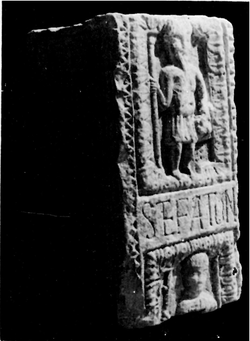
Using the dynastic instability in the neighboring lands, the city came into the hands of the Bosnian king Tvrtko I during the year of 1388. The previous bishop had likely been expelled, where the Ragusan Mihailo took his place, and was also given the office of the king's chancellor. These actions provoked a retaliation of king Sigismund, whose armies besieged Knin in September 1390. The city, along with other territories were returned to Sigismund in 1393. Upon his return from the disastrous battle of Nicopolis in 1396, the king spent a month in Knin to consolidate his holdings and state affairs of Dalmatia and Croatia, issuing various decrees together with his ban Nikola Gorjanski.[18] In 1401, the city was besieged by the Bosnian king Stephen Ostoja, who encamped in the adjacent Knin field (Kninsko polje), and remained there until the following year. The newly crowned king Ladislaus of Naples attained support from the castellan of Knin and issued his first decree there in 1403.
Because of frequent harassment, the citizens of Knin had to pay tribute to the duke Hrvoje Vukčić Hrvatinić, and for a short while, the city seemed to have been directly under his rule. The presence of Franciscans is for the first time mentioned in the 15th century, which were located in the old Saint Mary's church and monastery in the city. Apart from them, other religious buildings are mentioned for the first time such as the church of the Holy Spirit and the parish church of Saint Stephen.[19]
Between the 10th and the 13th century, Knin was also a notable military fort. The huge 10th century medieval Knin Fortress on Mt. Spas dominates the centre of town, and its present aspect dates back to the beginning of the 18th century. It is one of the largest fortification buildings in Dalmatia and is divided into the upper, middle and lower town, connected by drawbridges.
Its strategic position played an important role in many wars and power changes – the Republic of Venice often reflected on its importance as a key castle and the main entrance to Dalmatia, which it attempted to obtain during the 15th century.[20] During these years both the city, the ban and his dignitaries played a crucial role in the struggle for dominance over the coastal cities with Venice. In 1430 Knin and the Church of St. Bartolomeo in Kapitul were the centre of the "Union and Brotherhood of the Croats" (Latin: unio et fraternitas Croatorum), a congregation of Croatian nobles formed by 12 counties of Croatia in order to "preserve the fame and old customs of the Croatian Kingdom".[21][22] The supreme court of all of Croatia was located in Knin, where various officials and judges gather and were presided over by the vice-ban.[23]
It was in 1420 that the Nelipić noble family again regained their former role in Croatia with the emergence of Ivaniš Nelipić, which again distanced these territories from the crown. The Kaptol of Knin verified the pawning of Ivaniš's possessions so he could finance his campaigns against the Ottoman Turks and the Venetians. These possessions were later acquired after Ivaniš's death in 1435 by Anž of the House of Frankopan through the marriage with the Nelipić nobles. Knin and the surrounding possessions were restored to the crown upon Anž's death in 1437.[24] In 1454 an attempt between the Bosnian king and the Venetians was made to acquire the city, which was referenced as "capital and foremost place of Croatia" in their letters.[25]
During the reign of king Matthias Corvinus, the bishops of Knin were selected as the king's principal orators abroad in collecting the help needed against the invading Ottoman Empire. The bishop was thus first secretly involved at the pope to solicit financial aid for Matthias' military campaign. The city's distant surroundings quickly became a target for Ottoman raids. As the raids were becoming more frequent, one of them reached Knin, where a Franciscan monastery has been recorded to have been destroyed in 1469.
In 1493, the first attempt of siege by the Ottomans was undertaken. Very little information survived about this event, although Venetian letters state that a small number of nobles from the Knin castle descended to the adjacent fields and engaged in a battle with the Ottomans in which they were slaughtered. The ban John Corvinus and his deputies subsequently invaded and pillaged the Ottoman territories from Knin, in which a number of Ottoman soldiers, livestock and prisoners were captured. The Republic of Venice, which was gravely concerned about its possessions in Dalmatia, used the ban's absence and sent its troops to Knin to act as guards and sentries. The citizens of the city had refused to accept them, until they knew the ban's stance on this. It was agreed upon that the republic would financially contribute to maintaining the guards of the city, as well as other places, and would receive intelligence about the movement of the Ottoman troops as a compensation. In 1501, three Ottoman spies were caught and imprisoned by the vice-ban. They were sent by the Sanjak-bey of Bosnia, and had infiltrated Knin posing as friars that were on their way to sell vestments to the market. They were to investigate the situation in the Zadar surrounding.[26] It is known that Knin's burg housed a significant colony of merchants from the Dalmatian cities which also gives insight into its commercial importance.[27] The merchants often committed trade with other merchants from Dinara region and Bosnia, especially on Saint Bartholomew's Day, on which day a large annual trade fair took place in Knin.[28]
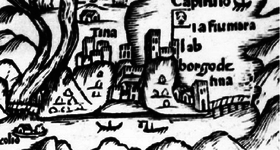
The last major conflict around Knin before the truce was in September 1502 when 2,000 Ottoman cavalrymen looted the area.[29] On 20 August 1503 King Vladislaus II concluded a 7-year peace treaty with Sultan Bayezid II. The armistice was generally respected by all sides,[30] during which Knin's defensive positions were strengthened in 1504. A period of severe famine started in 1505 that affected entire Dalmatia. In 1510 the plague halved Knin's population.
In 1510 around 1,000 Ottoman Akıncı raided the countryside of Knin. There had been word that viceban of Croatia was captured on that occasion. Baltazar Baćan (Hungarian: Boldizsár Batthyány), viceban of Slavonia, together with forces from the Zagreb Bishopry, managed to lift the siege of Knin in January 1513. Next year in February the Ottomans laid siege on Knin with 10,000 men from the Sanjak of Bosnia, but were unable to take the city and lost 500 troops. Knin's burg and outskirts were burned on this occasion.[31][32]
These clashes left Knin devastated and there was no news about the city for five years. Local population was decimated by war, hunger, plague and migration to safer places, and its economy was hindered by the seizure of crops and livestock. Due to Knin's strategic value, King Louis II responded to requests from captains of Knin, Skradin and Ostrovica and promised reinforcements of 1,000 infantry and 1,000 cavalrymen. However, it is unlikely that these forces arrived to the endangered towns.
On May 29, 1522, after the final siege, Knin fell to the Ottoman Empire, and Croats left the town in large numbers. The town was populated with Serb refugees by the Ottomans.
Ottoman and Venetian period
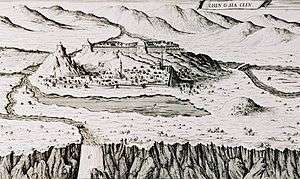
The bishops who held the title no longer resided in Knin after it fell to the Ottoman Turks in 1522. It was initially part of Sanjak of Kilis, laterly centre of Sanjak of Kırka, was founded in 1574.[2] It was briefly captured by Venice in 1648 during Cretan War. After Venice captured the district in 1688, the Bishop of Šibenik was appointed to administer the diocese, which was united in 1828 to Šibenik.[33] The bishopric is today the titular see of Tinum.[34]
A century and a half later, on September 11, 1688, it was captured by the Venetian Republic. Subsequently, the Croatian population partially returned and the Franciscans built a monastery and a church there in 1708. Ottomans aimed to retake Knin during Ottoman-Venetian War, but their siege was repulsed in 1715.
Habsburg era
Knin passed on to the Habsburgs together with Dalmatia in 1797 according to the Treaty of Campo Formio. After the Peace of Pressburg in 1805, the French Empire gained the city and incorporated it into the Illyrian Provinces in 1809. By 1813, the Austrians regained control over the town. By the end of the 19th century, as a part of the Habsburg domain of Dalmatia, Knin grew steadily, becoming an important commercial as well as road and railway center. In 1867, Knin became a part of Dalmatia – a territorial entity within Cisleithania. After the First World War Knin became a part of the State of Slovenes, Croats and Serbs in 1918, which subsequently became part of the Kingdom of Serbs, Croats and Slovenes (Kingdom of Yugoslavia after 1929).
Modern
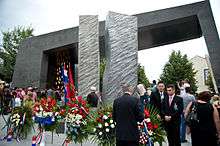
From October 1990,[35] eight months before Croatia declared independence (June 25, 1991) from Yugoslavia, Knin became the main stronghold for the Serbs in the Knin region, eventually becoming the capital city of the internationally unrecognised Republic of Serbian Krajina in 1991.[36] The leaders of Krajina were Knin locals: Milan Martić, a former police inspector later sentenced to 35 years imprisonment by the International Criminal Tribunal for the former Yugoslavia (ICTY) for war crimes, and Milan Babić, a dentist who after pleading guilty to war crimes at the ICTY committed suicide.[37] Serbs held the town until Croatian forces captured it during Operation Storm on August 5, 1995.[38] The date is today marked as a Victory Day in Croatia.
In February 2015, during the Croatia–Serbia genocide case, the International Court of Justice (ICJ) dismissed the Serbian lawsuit claim that Operation Storm constituted genocide ruling that Croatia did not have the specific intent to exterminate the country's Serb minority, though it reaffirmed that serious crimes against Serb civilians had taken place.[39] Fleeing civilians and people remaining in United Nations protected areas were subject to various forms of harassment, including military assaults and acts by Croatian civilians. On 8 August, a refugee column was shelled.[40] Human Rights Watch reported that the vast majority of the abuses were committed by Croatian forces. These abuses, which continued on a large scale even months after Operation Storm, included summary executions of elderly and infirm Serbs who remained behind and the wholesale burning and destruction of Serbian villages and property.[41]
The majority of the population had already fled by the time the Croatian Army took control of Knin.[42][43][44] At the end of the war, Knin's demographic composition changed greatly with the influx of Croat refugees from Bosnia and former Croat militia members. They replaced, to a great extent, those Serbs who fled during Operation Storm.[45] In 2015, Amnesty International report that Croatian Serbs continued to face discrimination in public sector employment and the restitution of tenancy rights to social housing vacated during the war.[46]
Geography
Knin is located in the northern Dalmatian region of Croatia, 56 kilometres east of the coastal town of Šibenik, at 44°02′18″N 16°11′59″E / 44.03833°N 16.19972°E.
The original Roman settlement developed on the foothills of the Dinaric Alps. It was on these foothills that the Knin Fortress was built. The source of the Krka river begins on the outskirts of the town.
Climate
Knin has a modified Mediterranean climate (Cfa, nearing the border with Csa) with hot dry summers and cool winters. Although the city is only some 50 km (31 mi) from the Adriatic Sea, an arm of the Mediterranean, the proximity of the Dinaric Alps to the north alters its climate. Knin is particularly known for its extremely hot summers: temperatures over 40 °C (104 °F) are common in July and August. The January average temperature is about 4 °C and in August is about 24 °C
| Climate data for Knin (1971–2000, extremes 1949–2014) | |||||||||||||
|---|---|---|---|---|---|---|---|---|---|---|---|---|---|
| Month | Jan | Feb | Mar | Apr | May | Jun | Jul | Aug | Sep | Oct | Nov | Dec | Year |
| Record high °C (°F) | 20.5 (68.9) |
22.3 (72.1) |
27.6 (81.7) |
29.2 (84.6) |
34.2 (93.6) |
39.3 (102.7) |
40.9 (105.6) |
41.4 (106.5) |
37.4 (99.3) |
31.6 (88.9) |
27.6 (81.7) |
21.6 (70.9) |
41.4 (106.5) |
| Average high °C (°F) | 8.9 (48) |
10.4 (50.7) |
14.1 (57.4) |
17.4 (63.3) |
23.0 (73.4) |
26.6 (79.9) |
30.1 (86.2) |
30.3 (86.5) |
25.4 (77.7) |
19.9 (67.8) |
13.7 (56.7) |
9.9 (49.8) |
19.1 (66.4) |
| Daily mean °C (°F) | 4.0 (39.2) |
5.1 (41.2) |
8.2 (46.8) |
11.5 (52.7) |
16.6 (61.9) |
20.1 (68.2) |
23.0 (73.4) |
22.5 (72.5) |
18.0 (64.4) |
13.3 (55.9) |
8.2 (46.8) |
5.0 (41) |
13.0 (55.4) |
| Average low °C (°F) | −0.2 (31.6) |
0.7 (33.3) |
3.3 (37.9) |
6.5 (43.7) |
10.6 (51.1) |
13.8 (56.8) |
16.2 (61.2) |
16.0 (60.8) |
12.2 (54) |
8.3 (46.9) |
3.8 (38.8) |
0.9 (33.6) |
7.7 (45.9) |
| Record low °C (°F) | −18.3 (−0.9) |
−18.4 (−1.1) |
−14.0 (6.8) |
−4.1 (24.6) |
−0.4 (31.3) |
4.3 (39.7) |
8.1 (46.6) |
6.8 (44.2) |
1.0 (33.8) |
−3.3 (26.1) |
−8.5 (16.7) |
−15.4 (4.3) |
−18.4 (−1.1) |
| Average precipitation mm (inches) | 75.9 (2.988) |
69.8 (2.748) |
74.7 (2.941) |
92.0 (3.622) |
90.5 (3.563) |
81.1 (3.193) |
43.7 (1.72) |
61.7 (2.429) |
108.1 (4.256) |
114.3 (4.5) |
112.3 (4.421) |
101.7 (4.004) |
1,025.8 (40.386) |
| Average precipitation days (≥ 0.1 mm) | 10.7 | 9.2 | 9.6 | 11.8 | 11.4 | 10.8 | 6.4 | 7.1 | 8.8 | 10.5 | 11.0 | 11.0 | 118.4 |
| Average snowy days (≥ 1.0 cm) | 1.3 | 1.2 | 0.2 | 0.0 | 0.0 | 0.0 | 0.0 | 0.0 | 0.0 | 0.0 | 0.3 | 0.5 | 3.5 |
| Average relative humidity (%) | 69.0 | 63.5 | 62.2 | 63.1 | 63.6 | 62.1 | 56.1 | 58.3 | 65.8 | 69.2 | 70.1 | 70.3 | 64.4 |
| Mean monthly sunshine hours | 120.9 | 146.9 | 182.9 | 189.0 | 244.9 | 270.0 | 325.5 | 297.6 | 234.0 | 182.9 | 123.0 | 108.5 | 2,426.1 |
| Source: Croatian Meteorological and Hydrological Service[47][48] | |||||||||||||
Demographics
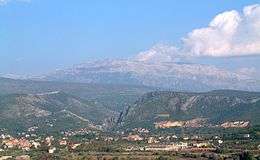
Before the Croatian War of Independence 87% of the population of the municipality and 79% of the city were Serbs.[49] During the war, most of the non-Serb population left Knin, while in the last days of the war the Serbs fled the city before it was re-captured by Croatian forces.[42][43][50] In February 2015, during the Croatia–Serbia genocide case, the judgment of the International Court of Justice stated that it is not disputed that a substantial part of the Serb population fled that region as a direct consequence of the military actions. The Croatian authorities were aware that the operation would provoke a mass exodus; they even to some extent predicated their military planning on such an exodus, which they considered not only probable, but desirable.[51]
In the 2001 census, the population of Knin was 11,128 in the city and 15,190 in the municipality, and the majority of its citizens were Croats with 76.45% and Serbs with 20.8%.[52] In the 2011 census, the city has 10,493 citizens, while the Knin municipality has 15,388.[1]
Knin's population is in more flux than that of other Croatian cities given that it has a major refugee problem: both with a large number of Croats who immigrated there and Serbs from Knin who are still refugees. Immigrant Croats form the majority in the city with only a scattered Serb presence in the surrounding villages.
Demographic history
Demographic history of the Knin municipality:[53]
| YEAR | 1880 | 1890 | 1900 | 1910 | 1948 | 1953 | 1961 | 1971 | 1981 | 1991 | 2001 | 2011 |
| Croats | 15.1% | 14.5% | 14.3% | 14.4% | 14.6% | 14.5% | 15.3% | 15.2% | 11.3% | 10.3% | 76.5% | 75.4% |
| Serbs | 82.3% | 84.5% | 83.5% | 84.2% | 84.7% | 84.1% | 82.1% | 80.7% | 72.8% | 85.5% | 20.8% | 23.0% |
| Others | 2.6% | 1% | 2.2% | 1.5% | 0.7% | 1.5% | 2.6% | 4.1% | 15.9% | 4.2% | 2.7% | 1.6% |
According to the Austrian Census held in 1900, the town of Knin had 1,302 residents, with the area surrounding Knin it had 22,810 citizens.[54] In 1910 the town had 1,270 citizens.[55] The 1857 data shows that 75,55% of the population was Roman Catholic.[56][57] Population of the town of Knin from 1830 to 2011, based on religion, language and ethnicity:
| Year | Total | Catholic | Orthodox | Serbo-Croatian | Italian | German | Other |
|---|---|---|---|---|---|---|---|
| 1910[55] | 1,270 | 833 (65.60%) | 433 (34.09%) | 1108 | 91 | 13 | 21 |
| 1900[54] | 1,302 | 835 (64.13%) | 467 (35.87%) | 1107 | 114 | 6 | 15 |
| 1857[56] | 1,039 | 785 (75.55%) | 254 (24.44%) | N/A | N/A | N/A | N/A |
| 1830[58] | 644 | 518 (80.43%) | 126 (19.57%) | N/A | N/A | N/A | N/A |
| Year | Total | Serbs | Croats | Yugoslavs | Other |
|---|---|---|---|---|---|
| 2001 | 11,128 | 1,269 (11.40%) | 9,546 (85.78%) | 0 (0%) | 188 (1.68%) |
| 1991 | 12,331 | 9,867 (80.01%) | 1,660 (13.46%) | 381 (3.08%) | 423 (3.43%) |
| 1981 | 10,933 | 6,516 (59.59%) | 1,701 (15.55%) | 2,421 (22.14%) | 295 (2.69%) |
| 1971 | 7,300 | 4,972 (68.10%) | 1,686 (23.09%) | 343 (4.69%) | 299 (4.09%) |
| 1961 | 5,116 | 3,064 (59.89%) | 1,671 (32.66%) | 81 (1.58%) | 247 (4.82%) |
| 1948 | 2,683 | 1,360 (50.69%) | 1,210 (45.10%) | 0 (0%) | 113 (4.21%) |
Archeology
The recently discovered Roman town Burnum is 18 km away from Knin in direction of Kistanje. There are the remains of the biggest amphitheater in Dalmatia built in 77 AD, during the rule of Emperor Vespasian which could host 8,000 people.[59]
The nearby villages Biskupija and Kapitul are extremely interesting archeological sites from the 10th century where many remains of medieval Croatian culture are found including churches, graves, decorations, and epigraphs.[60]
Sport
The main football club in Knin is NK Dinara, formed in 1913. NK Dinara's colours were black and white until 2005 when the club changed its colours to red, white and blue. NK Dinara plays in the 4th division in Croatia (1. Županijska liga Šibensko-kninska). The logo of NK Dinara is red, white, and blue (in that order) with the letter "D" in the middle of the logo.
Knin has a sports association which was formed in 1998. Basketball is also popular in Knin. The Croatian National basketball team has played a match in Knin. They played against Israel in 1999 where Croatia won the match 78:68. Other sports played in Knin are rugby, handball, volleyball, kickboxing, karate, tennis and taekwondo.
Transport
The most important intercity roadway in Knin is the Croatian state route D1. The route makes for easy access of Knin from the major coastal city of Split. The section of D1 from Knin to A1 highway will be upgraded to the expressway level in following years (with B1 expressway).
Knin is also an important railway junction as the railroads from the rest of Dalmatia and its cities of Zadar, Split and Šibenik pass through Knin, going north to the capital city of Croatia, Zagreb. There are four lines meeting in Knin station: to Perković (and then to Split or Šibenik), to Zadar, to Ogulin (and onwards to Karlovac, Zagreb) and to Martin Brod (and Bihać, Sisak, Zagreb). Only the former three lines offer passenger transport. The latter route, Knin-Bihać-Zagreb, passes through Bosnian territory, crossing the border many times, thus it is not used for passenger transport since the beginning of the war in 1991. However, it is the shortest route between Knin and Zagreb, and as such was electrified in 1987 (the catenary being subsequently destroyed by war operations in the early 1990s). Electrification had started from Yugoslav inland towards the coast and had only reached Knin, so today the Knin station is equipped with overhead catenary, but lines leaving the town are not.
Towns and villages in the municipality
- Golubić
- Knin
Biskupija
- Kninsko Polje
- Kovačić
- Ljubač
- Oćestovo
Orlic
Gallery
Template:Galéria
References
- 1 2 "Population by Age and Sex, by Settlements, 2011 Census: Knin". Census of Population, Households and Dwellings 2011. Zagreb: Croatian Bureau of Statistics. December 2012. Retrieved 2013-06-26.
- 1 2 http://www.knin.hr/povijest/
- ↑ Nikola Jakšić, Knin- hrvatska srednjovjekovna prijestolnica, Split 1995 pp. 7
- ↑ Illyricum sacrum, IV (Venice, 1775)
- ↑ TINIENSIA ARCHAEOLOGICA HISTORICA TOPOGRAPHICA II., Stjepan Gunjača pp. 23
- ↑ "Knin apartmani, hoteli, privatni smjetaj > Hrvatska > Jadran > Dalmacija". Retrieved 26 December 2014.
- ↑ Gunjača pp. 28
- ↑ Gunjača pp. 32
- ↑ Gunjača pp. 33
- ↑ http://hrcak.srce.hr/file/152117. Missing or empty
|title=(help) - ↑ Nikola Jakšić, Knin- hrvatska srednjovjekovna prijestolnica, Split 1995 pp. 19
- ↑ Gunjača pp. 54-55
- ↑ Gunjača pp. 35
- ↑ Donato Fabianich, Storia dei fratri minori dai primordi della joro istituzione in Dal· mazia e Bossina, fino ai giorni nostri, I, Zadar 1863, pp. 94.
- ↑ Miha Madijev, cap. XXIII.
- ↑ Gunjača pp. 52-53
- ↑ Gunjača pp. 55-56
- ↑ Gunjača pp. 60
- ↑ Nikola Jakšić, Knin- hrvatska srednjovjekovna prijestolnica, Split 1995 pp. 22
- ↑ Gunjača pp. 64
- ↑ Mladen Ančić: "Desetljeće od 1091. do 1102. u zrcalu vrela" (Summary: The decade between 1091 and 1102 according to the sources), Povijesni prilozi 17/1998, p. 253
- ↑ Damir Karbić: Hrvatski plemićki rod i običajno pravo, p. 109-111
- ↑ Gunjača pp. 76
- ↑ Gunjača pp. 68
- ↑ Gunjača pp. 72
- ↑ Gunjača pp. 82
- ↑ https://hrcak.srce.hr/file/77457. Missing or empty
|title=(help) - ↑ Nikola Jakšić, Knin- hrvatska srednjovjekovna prijestolnica, Split 1995 pp. 20-21
- ↑ Gunjača pp. 84
- ↑ Ive Mažuran: Povijest Hrvatske od 15. stoljeća do 18. stoljeća, p. 44-45
- ↑ Vjekoslav Klaić: Povijest Hrvata od najstarijih vremena do svršetka XIX. stoljeća, Knjiga četvrta, Zagreb, 1988, p. 302
- ↑ Gunjača pp. 88
- ↑ "CATHOLIC ENCYCLOPEDIA: See of Tinin (Dalmatia)". Retrieved 26 December 2014.
- ↑ Annuario Pontificio 2013 (Libreria Editrice Vaticana 2013 ISBN 978-88-209-9070-1), p. 991
- ↑ "Kronologija Domovinskog rata u Lici i Sjevernoj Dalmaciji". Retrieved 26 December 2014.
- ↑ Knin-Domovinski Rat
- ↑ Tanner, Marcus (1997) Croatia: a nation forged in war
- ↑ "U akciji "Oluja" oslobođen Knin" (in Croatian). Croatian Radiotelevision. 5 August 2011. Retrieved 24 December 2012.
- ↑ ICJ 3 February 2015, pp. 4, 141, 142
- ↑ ICJ 3 February 2015, pp. 4, 132, 133
- ↑ HRW 1996, p. 19
- 1 2 "LISTSERV 16.0 - Archives - Error". Retrieved 26 December 2014.
- 1 2 Pečat Vremena, Vesna Kljajić, OTV 11.05.2007
- ↑ The New York Times, 11 August 1995, p A1
- ↑ O Kninu; Povijest
- ↑ "Croatia report". 25 February 2015. Retrieved 2016-01-16.
- ↑ "Knin Climate Normals" (PDF). Croatian Meteorological and Hydrological Service. Retrieved 3 December 2015.
- ↑ "Mjesečne vrijednosti za Knin u razdoblju1949−2014" (in Croatian). Croatian Meteorological and Hydrological Service. Retrieved 3 December 2015.
- ↑ 1991 Yugoslav census
- ↑ The New York Times, 6 August 1995, p A1
- ↑ ICJ 3 February 2015, p. 131
- ↑ 2001 Croatian census
- ↑ Martin Glamuzina, Željka Šiljković, Nikola Glamuzina (June 2005). "Demographic Development of the Town of Knin in 1991/2001 Intercensal Period". Geoadria. 10 (1). Retrieved 2012-03-18.
- 1 2 Gemeindelexikon der im Reichsrate vertretenen Königreiche und Länder, Bd. 14 Dalmatien, p. 30, 32
- 1 2 Spezialortsrepertorium der österreichischen Länder I-XII, Wien, 1915–1919
- 1 2 Mithad Kozličić, Ante Bralić, Stanovništvo Kraljevine Dalmacije prema službenim izračunima i popisima 1828.-1857., p. 252
- ↑ Statistica generale della Dalmazia / edita dalla Giunta provinciale ; [compilata da Luigi Serragli]. Divisione 4, Fasc. 1 : Statistica della popolazione della Dalmazia. - 1862
- ↑ Mithad Kozličić, Ante Bralić, Stanovništvo Kraljevine Dalmacije prema službenim izračunima i popisima 1828.-1857., p. 81
- ↑ Andrea Devlahović. ".:: fragmenti ONLINE :::::::: f 1/I 2003. Burnum". Retrieved 26 December 2014.
- ↑ Sv. Ante Knin
- "Application of the Convention on the Prevention and Punishment of the Crime of Genocide (Croatia v. Serbia)" (PDF).
- "Croatia: Impunity for abuses committed during "Operation Storm" and the denial of the right of refugees to return to the Krajina" (PDF). Human Rights Watch. August 1996.
External links
| Wikimedia Commons has media related to Knin. |
- Knin city website (Croatian)
- Touristical information about Knin area
- National Tourist Board about Knin
